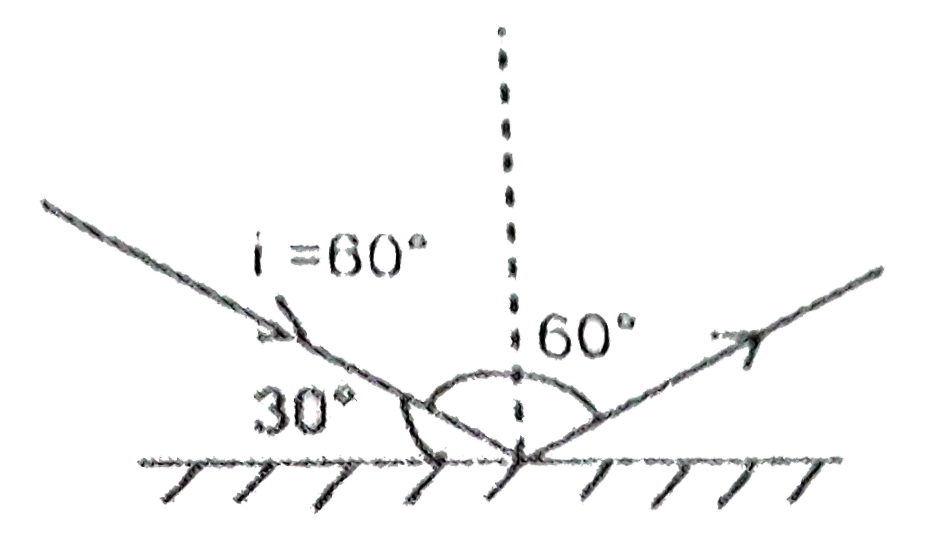A plane polarized light is incident normally on a tourmaline plate. Its E vector make an angle of 60∘ with the optic axis of the plate. Find the percentage difference between initial and final intensities
50%
25%
75%
90%
The correct Answer is:C
To solve the problem of finding the percentage difference between the initial and final intensities of plane polarized light incident on a tourmaline plate, we can follow these steps:
1. Understand the Problem: We have plane polarized light incident normally on a tourmaline plate. The electric field vector (E vector) of the light makes an angle of 60∘ with the optic axis of the plate.
2. Use Malus's Law: According to Malus's Law, when polarized light passes through a polarizer, the intensity of the transmitted light I is given by:
I=I0cos2(ϕ)
where I0 is the initial intensity of the light and ϕ is the angle between the light's electric field vector and the optic axis of the polarizer.
3. Identify the Values: In our case:
- Initial intensity I0
- Angle ϕ=60∘
4. Calculate the Final Intensity:
I=I0cos2(60∘)
We know that cos(60∘)=12, so:
I=I0(12)2=I0⋅14
5. Calculate the Percentage Difference:
The percentage difference between the initial intensity I0 and the final intensity I is given by:
Percentage Difference=I0−II0×100
Substituting I from the previous step:
Percentage Difference=I0−I04I0×100
Simplifying this:
=I0−I04I0×100=I0(1−14)I0×100
=(1−14)×100=34×100=75%
6. Final Result: The percentage difference between the initial and final intensities is 75%.
I=I0cos2(ϕ)
where I0 is the initial intensity of the light and ϕ is the angle between the light's electric field vector and the optic axis of the polarizer.
- Initial intensity I0
- Angle ϕ=60∘
I=I0cos2(60∘)
We know that cos(60∘)=12, so:
I=I0(12)2=I0⋅14
The percentage difference between the initial intensity I0 and the final intensity I is given by:
Percentage Difference=I0−II0×100
Substituting I from the previous step:
Percentage Difference=I0−I04I0×100
Simplifying this:
=I0−I04I0×100=I0(1−14)I0×100
=(1−14)×100=34×100=75%
Topper's Solved these Questions
- WAVE OPTICSBOOK - DC PANDEYCHAPTER - WAVE OPTICSEXERCISE - For JEE main (Only one option is Correct )
22 Videos
- WAVE OPTICSBOOK - DC PANDEYCHAPTER - WAVE OPTICSEXERCISE - For JEE Advanced Only one option is correct
23 Videos
- WAVE OPTICSBOOK - DC PANDEYCHAPTER - WAVE OPTICSEXERCISE - match column
4 Videos
- SOLVED PAPERS 2018BOOK - DC PANDEYCHAPTER - SOLVED PAPERS 2018EXERCISE - JIPMER
22 Videos
Similar Questions
A plane polarized light with intensity I0 is incident on a polaroid with Electric Field vector making an angle of 60∘ with transmission axis of polaroid. The intensity of the resulting light will be
View SolutionThe axes of a polarizer and an analyzer are oriented at 30∘ to each other.
(a) If unpolarized light of intensity I0 is incident on them, what is the intensity of the transmitted light?
(b) Polarized light of intensity I0 is incident on this polarizer-analyzer system. If the amplitude of the light makes an angle of 30∘ with the axis of the polarizer, what is the intensity of the transmitted light?
View Solution
Knowledge Check
A ray of unpolarised light is incident on a glass plate at the polarizing angle of 57∘. Now,
Aboth the reflected and transmitted rays will be completely polarisedBthe reflected ray will be completely polarised and transmitted ray will be partially polarisedCthe reflected ray will be partially polarised and transmitted ray will be completely polarisedDboth the reflected and the transmitted rays will be partially polarised.A plane polarized beam of intensity I is incident on a polariser with the electric vector inclined at 30∘ to the optical axis of the polariser passes through an analyzer whose optic axis is inclined at 30∘ to that of polariser. Intensity of light coming out of the analyzer is
 A(9/16)IB(3/4)IC(1/4)ID(√3/2)I
A(9/16)IB(3/4)IC(1/4)ID(√3/2)IIf a ray of light incident on a plane mirror is such that it makes an angle of 30∘ with the mirror, then the angle made by the reflected ray with the mirror is
A35∘B60∘C90∘D30∘
A line lies in XZ-plane and makes an angle 60∘ with Z-axis, find its inclination with X-axis.
View SolutionIf a light ray incident on a plane mirror makes an angle 30∘ with it, find the angle of incidence and angle of reflection.

View SolutionWhen unpolarised light is incident on a plane glass plate at Brewster’s angle, then which of the following statements is correct?
View SolutionA quartz plate cut parallel to its optical axis is placed between two corssed Nicol prisms so that principle directions form an angle of 45∘ with the optical axis of the plate. What is the minimum thickness of that plate transmitting light of wavelength λ=643nm with maximum intensity while greatly reducing the intensity of transmitting light of wavelength λ2=564nm? The difference of refractive indieces indices for extroardianry and ordinary rays is assumed to be equal to ne−n0=0.0090 for both wavelengths.
View SolutionA polarised light intensity I0 is passed through another polariser whose pass axis makes an angle of 60∘ with the pass axis of the former, What is the intensity of emergent polarised light from second polarised?
View Solution
